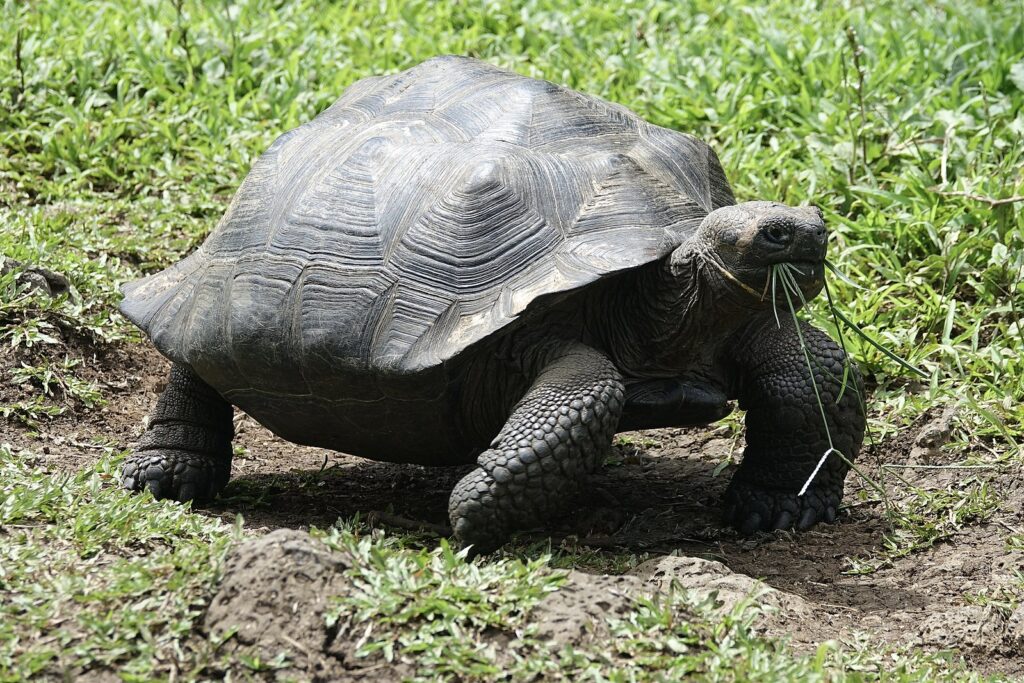
Image: Galapagos tortoise Wikimedia Commons CC 2.0
How long do Galapagos Tortoises live? Ridiculously long! They have been recorded living for over a hundred years! Native to the Galapagos Islands, they’ve adapted to their harsh environments. With slow metabolisms and the ability to survive without food or water for long periods, they have mastered endurance.
Plus, each island has its own species of tortoise, with variations in size and shell shape. This makes them even more fascinating! The best way to appreciate these ancient reptiles is to visit them in their natural habitat. It’s an awe-inspiring experience that will leave you in admiration of their wisdom and resilience. The Galapagos Tortoise – the Energizer Bunny of the animal kingdom!
Key Takeaways
- The Galapagos tortoise is known for its long lifespan, with some individuals living over 100 years.
- The average lifespan of a Galapagos tortoise is around 80-100 years, but some have been known to live even longer.
- The longevity of Galapagos tortoises can be attributed to their slow metabolism, large size, and ability to store water and food.
- The oldest recorded Galapagos tortoise lived to be 152 years old, making it one of the longest-lived animals on Earth.
- Conservation efforts are crucial to protect the Galapagos tortoise population and ensure their survival for future generations.
Overview of Galapagos Tortoise
To gain an understanding of the Galapagos Tortoise, delve into the section exploring the overview of this fascinating creature. Discover its physical characteristics and unearth intriguing insights about its long lifespan. Physical characteristics of Galapagos Tortoise will be revealed, shedding light on what makes this species so unique.
Physical characteristics of Galapagos Tortoise
The Galapagos Tortoise is renowned for its unique traits. Its size, shape and features create a distinct look in the animal kingdom. It’s one of the largest tortoises, with males weighing up to 550 pounds and females around 250. They have a large, dome-shaped shell that shields them from predators – it can be dark brown to grayish-black. Their necks are long and their legs are sturdy, aiding them to get food on the ground or reach vegetation higher up. Some subspecies have a saddleback shape on their shells, which helps to identify different populations.
These tortoises have specialized scales on their feet that give them a better grip on rocky surfaces, perfect for navigating their volcanic habitat. In 1971, a volcanic eruption put several species on Isabela Island in danger, including the tortoises. However, due to conservation efforts, over 500 tortoises were relocated to safety, saving countless lives and preserving this incredible species.
The Galapagos Tortoise – age old resilience, nourished by grass and sunshine!
Lifespan of Galapagos Tortoise

To understand the lifespan of Galapagos Tortoises, delve into the factors that impact their longevity. Explore the sub-sections: factors affecting the lifespan. Discover the key elements that influence how long these magnificent creatures can live.
Factors affecting the lifespan
The Galapagos Tortoise is an ancient being that has endured over time. To ensure its long-term survival, several factors must be taken into consideration.
Natural predators such as dogs, cats, and rats pose a significant threat. Additionally, human activities like deforestation and construction can lead to a decline in population.
Climate change can negatively impact the health and well-being of these tortoises. Disease and infections, such as Newcastle disease, can weaken their immune system and shorten their lifespan. Access to food, such as cacti, fruits, grasses, and leaves, is essential for their overall health and longevity.
The geographic location of the Galapagos Tortoises can affect the availability of resources and exposure to threats. On islands with limited vegetation, they may struggle to find food. Pollution from human activity can also contribute to their decline.
Conservation efforts should protect their natural habitat and control invasive species. Awareness should be generated among local communities about the importance of preserving these ancient beings. Educational programs and ecotourism can foster a sense of responsibility towards conservation efforts.
Longevity of Galapagos Tortoise in the wild
To understand the longevity of Galapagos Tortoise in the wild, delve into natural predators and threats, diet, and habitat. Explore how these factors contribute to their lifespan and ensure their survival.
Natural predators and threats
Brave Galapagos Tortoise, Diego, is a reminder of the resilience of these majestic creatures. Diego managed to survive in the wild, although faced with numerous threats from introduced predators.
Feral dogs and pigs, as well as habitat loss, disease, and pollution, all pose a major threat to the survival of these incredible reptiles. Their unique genetic makeup makes them highly vulnerable.
To ensure their future, conservation efforts must prioritize safeguarding the Galapagos Tortoises. The secret to their longevity? An all-you-can-eat buffet of cacti and patience!
Diet and habitat
The Galapagos tortoise, renowned for its long life, needs a special diet and habitat to survive in the wild. It’s important to understand these elements.
To get a better idea of their nutrition and preferred environments, let’s take a closer look. The table below shows a complete summary of their diet and habitats.
| Diet | Habitat |
|---|---|
| Herbivorous | Lush vegetation |
| Mainly plants | Dry forests |
| Grasses | Arid lowlands |
| Cacti | Coastal regions |
| Fruits | Highlands |
Besides these basics, it is significant to note that the Galapagos tortoises have special habits related to food and habitat. For example, they often migrate over long distances to find food or suitable surroundings.
To help keep the Galapagos tortoise population healthy, certain measures can be taken.
- Designating protected areas to preserve their natural habitats would ensure lush vegetation and different microclimates.
- Controlling foreign species like goats and rats would stop them competing for resources on the islands.
By taking these steps, we can effectively conserve the Galapagos tortoise’s diverse diet and specific habitat preferences. This is essential for supporting their longevity in the wild and guaranteeing their existence as extraordinary animals on our planet. Have the Galapagos Tortoises discovered the key to immortality, or are they simply really good at hiding in their habitats?
Longevity of Galapagos Tortoise in captivity
To ensure the longevity of Galapagos Tortoise in captivity, proper care and conservation efforts are crucial. In this section, we will explore the essential sub-sections: Care and conservation efforts. This will shed light on the measures taken to protect these magnificent creatures and promote their well-being in captivity.
Care and conservation efforts
The care and conservation efforts for the long life of Galapagos tortoises in captivity are very important. Three main aspects focus on this:
- Conservation breeding programs. To guarantee genetic diversity and increase numbers, tortoises are bred in a controlled atmosphere. This prevents endangered species from going extinct.
- Habitat preservation. It is essential to protect the natural habitats of Galapagos tortoises for their well-being. Efforts to conserve and restore their natural ecosystems provide them with food and shelter.
- Education and awareness. Educating people about the importance of conserving Galapagos tortoises is vital for their survival. Raising awareness of their special characteristics and how important they are to their environments helps people to protect them.
Captive breeding has helped to increase the population of Galapagos tortoises over the years. An example is Lonesome George, believed to be the last Pinta Island tortoise. Despite attempting to find him a mate, he died without reproducing. His story, though, continues through scientific research and conservation initiatives. In conclusion, even if the Galapagos Tortoise outlive us, we can take comfort in the fact that we have plenty of time to perfect our own fashion choices.
Frequently Asked Questions
1. How long does a Galapagos tortoise live?
A Galapagos tortoise can live for more than 100 years. Some individuals have been known to reach ages of over 150 years.
2. What is the average lifespan of a Galapagos tortoise?
The average lifespan of a Galapagos tortoise is around 100 years. However, this can vary depending on factors such as habitat, diet, and overall health.
3. Are Galapagos tortoises the longest-living tortoise species?
Yes, Galapagos tortoises are considered one of the longest-living tortoise species in the world. They have an impressive lifespan compared to other tortoise species.
4. What factors contribute to the long lifespan of Galapagos tortoises?
Several factors contribute to the long lifespan of Galapagos tortoises. These include their slow metabolic rate, ability to store water and food during periods of scarcity, and their lack of natural predators.
5. Do Galapagos tortoises show signs of aging?
Galapagos tortoises do show signs of aging just like any other living being. As they grow older, their shells may show more wear and tear, and they may experience a decrease in activity level.
6. How can the age of a Galapagos tortoise be determined?
The age of a Galapagos tortoise can be determined by analyzing growth rings on their shells. Each year, a new ring is added, similar to the growth rings on a tree. Counting these rings can give an estimate of the tortoise’s age.
Conclusion
The Galapagos tortoise is an extraordinary creature that has grabbed the interest of scientists and nature lovers worldwide. Its remarkable lifespan has been a subject of intrigue for many years. So, how long does this remarkable being really live?
To answer this question, we must first examine the elements that add to the lifespan of a Galapagos tortoise. These tortoises are known for their slow growth rate and late maturity. It takes them numerous decades to reach sexual maturity. Females arrive at it at about 20 years and males at around 30 years.
When they reach maturity, these tortoises have a long voyage ahead. In their natural environment, they confront different difficulties, for example, predation, diseases, and limited food sources. Be that as it may, if they endure these challenges, they can live an amazingly long life.
Studies have shown that Galapagos tortoises have the capability to live for more than 100 years! Actually, the oldest recorded Galapagos tortoise lived up to a remarkable age of 170 years. This endurance can be ascribed to their slow digestion and capacity to survive in extreme conditions.
References




